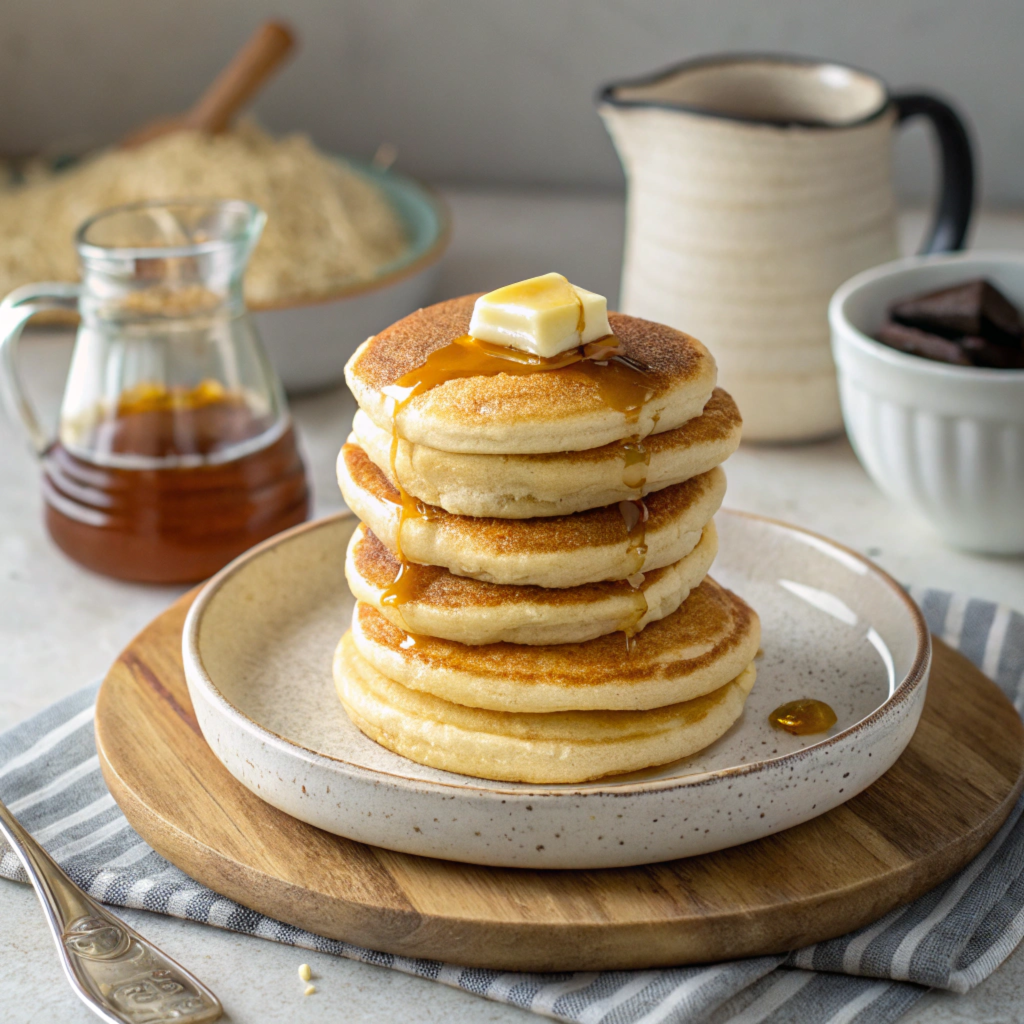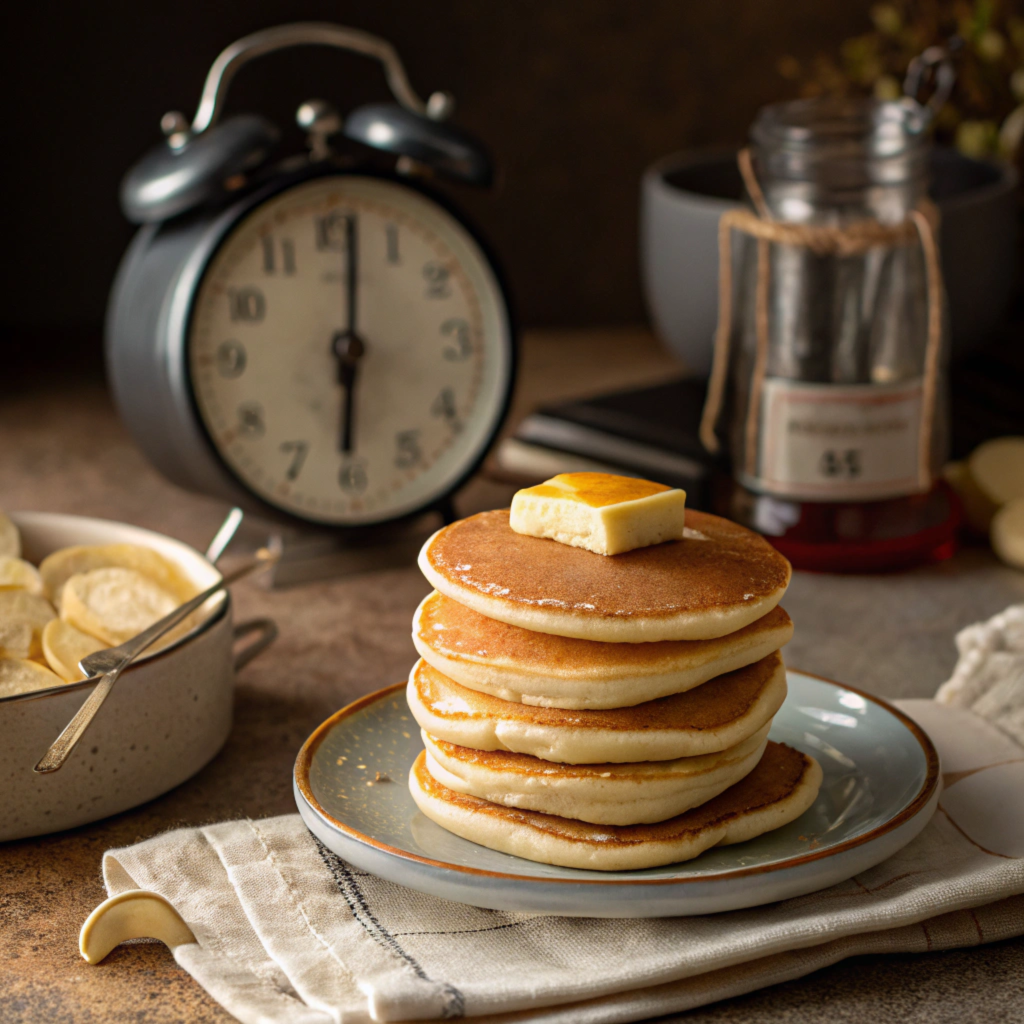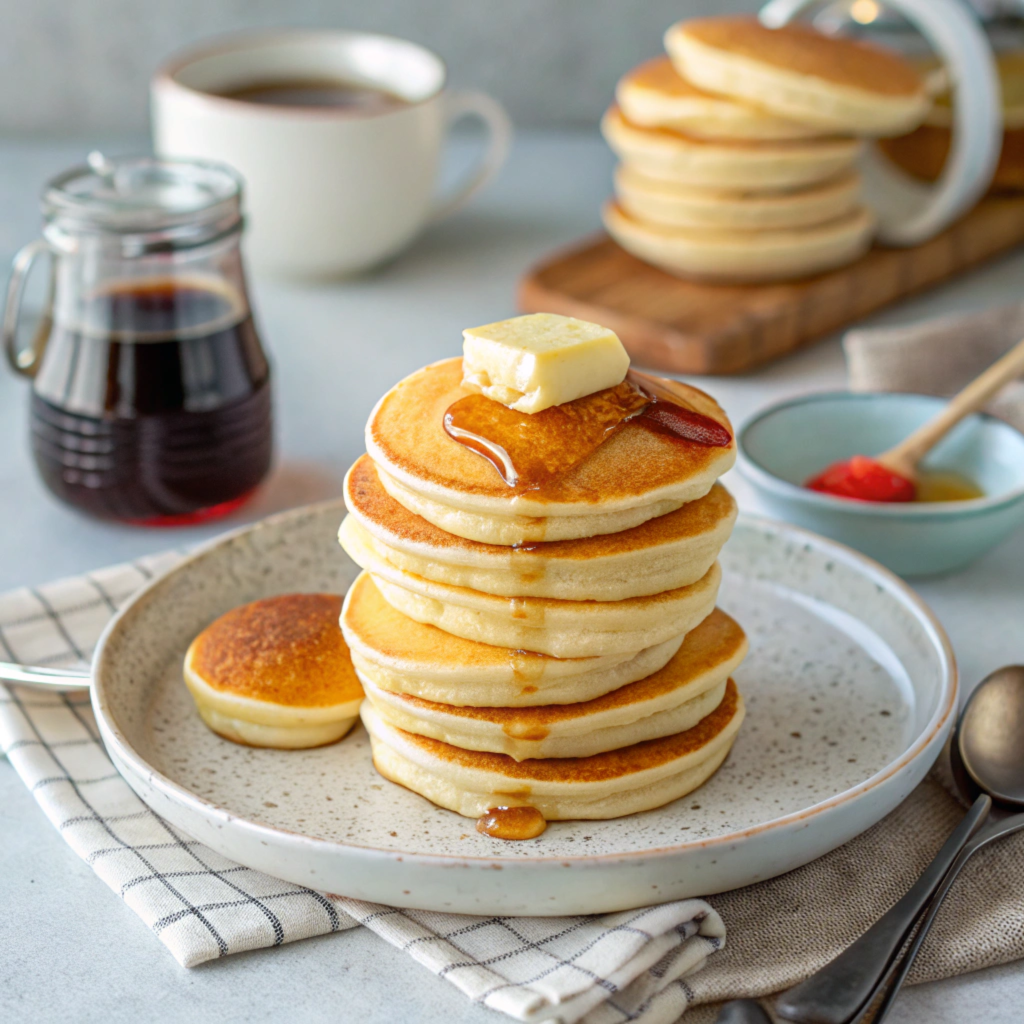
Mini pancakes are a breakfast favorite known for their fluffy texture and bite-sized convenience. However, cooking them to perfection requires precise timing. If you cook them too quickly, they can end up undercooked on the inside. Cook them too long, and they become dry and hard. This guide explains the ideal cooking time for mini pancakes and how to adjust based on different factors.
Why Cooking Time Matters for Mini Pancakes
Cooking time is essential for achieving fluffy, evenly cooked mini pancakes. Proper timing ensures the pancakes are golden brown outside and fully cooked inside. If the timing is off, you’ll end up with flat, doughy, or burnt pancakes.
Key Cooking Aspects and Why They Matter
| Aspect | Why It Matters |
|---|---|
| Even Browning | Creates visually appealing pancakes |
| Moist, Cooked Centers | Avoids raw or doughy interiors |
| Fluffy Texture | Keeps pancakes light and airy |
| Consistent Cooking | Ensures uniform results per batch |
Importance of Proper Timing for Fluffy Pancakes
Getting the timing right helps maintain a soft, tender texture. Mini pancakes are smaller than regular pancakes, meaning they cook faster and require close attention. Here’s how proper timing impacts different aspects of cooking:
Key Timing Effects
| Cooking Effect | How Timing Helps |
|---|---|
| Golden Exterior | Forms a light crust for better taste |
| Soft Inside | Ensures the center stays moist |
| Correct Rise | Allows baking powder to work fully |
| Good Texture | Prevents dry, rubbery pancakes |
Factors That Influence Cooking Time
Several factors influence how long mini pancakes take to cook. Adjust these elements to ensure the best results:
Cooking Factors and Their Impact
| Factor | How It Affects Cooking |
|---|---|
| Batter Consistency | Thicker batter needs longer cooking |
| Pan Material | Cast iron retains heat for even cooking |
| Heat Settings | Medium heat ensures slow, steady cooking |
| Cooking Method | Stove, oven, or pancake maker timing |
Tips for Perfect Cooking Timing
- Preheat the Pan Properly: Ensure the pan is hot before pouring the batter to avoid sticking and uneven cooking.
- Check for Bubbles: Flip the pancakes when small bubbles form on the surface.
- Monitor the Heat: Use medium heat for even cooking and adjust as needed.
- Keep Pancakes Small: Consistent size ensures uniform cooking.
Signs of Correctly Cooked Mini Pancakes
Knowing when mini pancakes are perfectly cooked helps avoid undercooked or burnt batches. Look for these indicators:
Cooking Signs and Their Meaning
| Sign | What It Means |
|---|---|
| Golden Edges | Pancakes are ready to flip |
| Bubbly Surface | Indicates the first side is cooked |
| Even Browning | Shows consistent heat distribution |
| Fully Set Centers | Means the inside is fully cooked |
Common Mistakes to Avoid
- Flipping Too Soon: Flip only when bubbles form and edges set.
- Cooking on High Heat: Use medium heat to prevent burning.
- Skipping the Preheat: A cold pan causes uneven cooking.
- Overcrowding the Pan: This lowers the heat and slows cooking.
Cooking Mini Pancakes on the Stove
Cooking mini pancakes on the stove is the most popular method due to its simplicity and quick results. It involves preheating a pan, managing heat levels, and flipping the pancakes at the right time. This section covers everything you need to know about cooking mini pancakes on the stove, including heat settings, cooking times, and tips for perfect results.

How to Cook Mini Pancakes on a Skillet
Cooking on a skillet requires controlling heat and using the right tools to ensure even cooking. Follow these essential steps:
Steps for Cooking on a Skillet
| Step | Action | Why It’s Important |
|---|---|---|
| Preheat the Pan | Heat pan for 3-5 minutes | Prevents sticking and ensures even cooking |
| Grease the Pan | Use non-stick spray or butter | Avoids sticking and burning |
| Pour the Batter | Use a spoon or scoop for even size | Ensures uniform cooking |
| Flip Pancakes | Flip when bubbles form on surface | Prevents burning and ensures cooked centers |
Preheating the Pan
Preheating is crucial to prevent sticking and ensure golden-brown results. Here’s how to preheat correctly:
| Preheating Tips | Why It Helps |
|---|---|
| Use Medium Heat | Avoids burning the batter |
| Preheat for 3-5 Minutes | Ensures even cooking surface |
| Check Pan Readiness | Sprinkle water; it should sizzle |
| Add Grease After Heating | Keeps pancakes from sticking |
Cooking Time Per Side
The exact cooking time depends on heat settings and batter thickness. Follow these cooking time guidelines for best results:
Cooking Times
| Side | Time Required | What to Look For |
|---|---|---|
| First Side | 1-2 minutes on medium heat | Bubbles forming on the surface |
| Second Side | 30-60 seconds after flipping | Golden-brown bottom |
Tip: Do not press down on the pancakes while cooking, as this removes air, making them dense.
Checking for Doneness
Knowing when your pancakes are done prevents raw centers or burnt edges. Look for these doneness indicators:
| Sign of Doneness | Meaning |
|---|---|
| Golden-Brown Edges | Pancakes are cooked through |
| Bubbly Surface | First side is ready to flip |
| Firm, Set Centers | Pancakes are fully cooked |
| Non-Sticking Surface | Properly greased and cooked |
Common Mistakes to Avoid
Avoid these common cooking mistakes when using a stove:
| Mistake | Why It’s a Problem | How to Fix It |
|---|---|---|
| Flipping Too Early | Pancakes will break apart | Wait for bubbles to form |
| Overcrowding the Pan | Uneven heat distribution | Cook in batches |
| Using High Heat | Causes burning and raw centers | Use medium heat only |
| Skipping the Preheat | Causes sticking and unevenness | Preheat for at least 3 minutes |
Pro Tips for Better Results
- Use a Non-Stick Pan: This reduces the need for extra oil or butter.
- Keep Pancakes Uniform: Use a tablespoon or small ice cream scoop to ensure even sizes.
- Check Heat Regularly: Adjust heat if pancakes are browning too fast or too slowly.
- Keep Cooked Pancakes Warm: Use a preheated oven set to 200°F (95°C) while finishing batches.
Cooking Mini Pancakes in the Oven
Cooking mini pancakes in the oven is a convenient method, especially when making large batches. It ensures even cooking and reduces the need for constant flipping. This hands-free method is ideal for busy mornings, parties, or meal prep.
Baking Mini Pancakes for Batch Cooking
Baking mini pancakes is perfect when you need to serve many people at once. Using a muffin tin or a baking sheet ensures consistent sizes and reduces cooking time. This method is also easier to manage compared to cooking pancakes on the stove.
Preheating the Oven
Preheating the oven is crucial to ensure even baking. Set the oven to 375°F to 400°F (190°C to 200°C), depending on your oven type. Preheat for 5-10 minutes until the temperature is stable. A properly preheated oven helps pancakes rise evenly and achieve a golden-brown color.
Baking Time
The baking process for mini pancakes usually takes about 8-10 minutes. Here’s how to bake them correctly:
- Prepare the Batter: Mix the pancake batter while the oven preheats. Ensure the batter is smooth but not too thin.
- Grease the Baking Surface: Lightly grease a muffin tin or baking sheet to prevent sticking. Use non-stick spray or melted butter.
- Scoop the Batter: Pour the batter into the muffin cups or spoon small amounts onto a lined baking sheet. Leave some space between each portion.
- Bake the Pancakes: Place the tray in the oven and bake for 8-10 minutes or until the tops are golden brown. Avoid opening the oven frequently, as this can affect the cooking process.

Flipping for Even Browning (Optional)
If using a flat baking sheet, flipping the pancakes halfway through cooking ensures even browning on both sides. Carefully turn them with a spatula after about 5 minutes and bake for an additional 3-5 minutes until fully cooked. This step is optional when using a muffin tin.
Testing for Doneness
Check for doneness using the following methods:
- Toothpick Test: Insert a toothpick into the center of a pancake. If it comes out clean, the pancakes are done.
- Golden-Brown Appearance: Look for evenly browned edges and a light, golden surface.
- Springy Texture: Gently press the center of a pancake. If it springs back, it’s fully cooked.
Tips for Batch Cooking and Reheating
- Make Extra Batches: Bake multiple trays at once to save time.
- Store Properly: Allow pancakes to cool completely before storing them in an airtight container.
- Reheat Before Serving: Warm pancakes in the oven at 300°F (150°C) for 5-7 minutes before serving.
Cooking Mini Pancakes in a Mini Pancake Maker
Using a mini pancake maker is one of the easiest and fastest ways to cook perfectly round and fluffy mini pancakes. This method ensures even cooking with minimal effort, making it ideal for quick breakfasts or fun family cooking sessions. Follow these detailed steps to get the best results from your mini pancake maker.
How to Use a Mini Pancake Maker
Cooking with a mini pancake maker is straightforward, especially if you follow the manufacturer’s instructions. Before getting started, gather all ingredients and prepare the batter.
Prepping the Pancake Maker
- Preheat the Pancake Maker: Plug in the pancake maker and wait for the indicator light to turn on. This usually takes 2-3 minutes, depending on the brand. Preheating ensures even cooking from the start.
- Lightly Grease the Surface: Apply a thin layer of non-stick spray or melted butter to prevent sticking. Use a heat-resistant brush or paper towel for even application. Avoid over-greasing, as too much oil can cause uneven browning. mini pancakes take to cook
Cooking and Flipping Mini Pancakes
- Pour the Batter: Use a small ladle or tablespoon to pour the batter into each mold. Fill each section about three-quarters full to allow the pancakes to rise without spilling over.
- Close the Lid: Gently close the pancake maker’s lid without pressing down too hard. This ensures even cooking on both sides.
- Cook for 1-2 Minutes: Let the pancakes cook for 1-2 minutes until the edges set and bubbles form on the surface. Cooking time may vary based on the thickness of the batter and the pancake maker’s heat settings.
- Check for Doneness: Lift the lid carefully and check if the pancakes have a golden-brown color. If needed, cook for an additional 30 seconds.
Flipping for Extra Crispiness (Optional)
Most mini pancake makers cook both sides simultaneously, so flipping is usually unnecessary. However, if you prefer extra-crispy pancakes, use a silicone spatula to flip each pancake after the first minute. Let them cook for another 30-60 seconds until golden and crispy.
Removing and Serving
- Use a Spatula for Easy Removal: Carefully lift the pancakes from the molds using a silicone or plastic spatula to avoid scratching the surface. Avoid using metal utensils that could damage the non-stick coating.
- Serve Hot with Toppings: Transfer the cooked pancakes to a serving plate. Keep them warm by covering them with foil or placing them in a preheated oven at 200°F (95°C). Add your favorite toppings like maple syrup, whipped cream, fresh fruit, or chocolate chips. mini pancakes take to cook
Tips for Better Results
- Use Consistent Batter: Ensure the batter is smooth but not too runny. Thick batter creates fluffier pancakes, while thinner batter cooks faster.
- Avoid Overfilling: Pour the batter slowly and avoid overfilling the molds, as this can cause uneven cooking or spillage.
- Don’t Press the Lid: Allow the weight of the lid to sit naturally on the pancakes. Pressing down can make the pancakes flat.
- Clean the Maker After Use: Once cooled, wipe the pancake maker with a damp cloth to keep it in top condition.
Troubleshooting Common Issues
- Undercooked Centers: Increase the cooking time by 30 seconds or ensure the batter isn’t too thick.
- Burnt Edges: Reduce the preheating time or lower the batter’s sugar content, as sugar can cause faster browning.
- Sticky Pancakes: Ensure the cooking surface is properly greased before each batch.
Here’s Part 5: Factors That Affect Cooking Time, expanded to 600 words following Yoast SEO standards: mini pancakes take to cook
Factors That Affect Cooking Time for Mini Pancakes
Cooking mini pancakes to perfection requires understanding the various factors that influence how long they take to cook. These factors include batter consistency, heat settings, pan material, and even the type of cooking method used. Paying attention to these elements ensures evenly cooked, fluffy, and golden-brown mini pancakes every time.
1. Batter Consistency
The consistency of the pancake batter plays a crucial role in determining how long the pancakes need to cook. Thicker batter requires longer cooking times, while thinner batter cooks faster but may result in flatter pancakes.
How to Adjust Batter Consistency:
- For Thicker Pancakes: Add extra flour to create a thicker batter. Cook for 2-3 minutes per side over medium heat.
- For Thinner Pancakes: Add more milk to make a pourable batter. Cook for 1-2 minutes per side over medium-high heat.
2. Pan Material and Thickness
The type of pan or cooking surface used can significantly impact cooking time. Different materials retain and distribute heat differently:
- Non-Stick Pans: These pans heat quickly and evenly, making them perfect for fast cooking. They require medium heat to prevent burning.
- Cast Iron Skillets: These pans retain heat longer, ensuring even cooking but needing a longer preheat time. Use low to medium heat for best results.
- Electric Griddles: Electric griddles provide even heat and allow you to adjust temperature settings precisely.
3. Heat Settings
Proper heat management ensures that pancakes cook evenly without burning. Medium to medium-high heat is ideal, but it can vary based on your cooking method:
- Low Heat: Results in longer cooking times and softer pancakes. Use this for delicate batters.
- Medium Heat: Provides balanced cooking, allowing pancakes to cook through without burning.
- High Heat: Speeds up cooking but increases the risk of burning. Only use for thin batters that cook quickly.
4. Cooking Surface Temperature
Maintaining the correct cooking surface temperature is essential to avoid pancakes that are raw inside or burnt outside. Ensure the surface is evenly heated before adding the batter:
- Preheating Tip: Preheat the pan for at least 3-5 minutes over medium heat. Test readiness by sprinkling a few drops of water on the surface; they should sizzle and evaporate quickly.
- Even Heat Distribution: Use a pan with a thick base for consistent heat retention.
5. Pancake Size and Thickness
The size and thickness of the pancakes determine how long they should cook. Larger, thicker pancakes take longer than smaller, thinner ones:
- Small Pancakes: Cook for 1-2 minutes per side over medium heat.
- Thick Pancakes: Cook for 2-3 minutes per side and reduce heat if needed to avoid burning.
6. Type of Cooking Method
Different cooking methods require different times and techniques:
- Stove: Cook pancakes on a skillet or griddle for 1-2 minutes per side on medium heat.
- Oven: Bake pancakes for 8-10 minutes at 375°F (190°C).
- Pancake Maker: Use a preheated mini pancake maker for 1-2 minutes per batch.
Tips for Managing Cooking Time
- Use Consistent Heat: Maintain steady heat throughout the cooking process.
- Avoid Overcrowding: Cooking too many pancakes at once lowers the pan’s temperature.
- Keep Batter Ready: Mix batter just before cooking to avoid over-thickening due to settling.
- Flip Only Once: Flip pancakes only when bubbles form and the edges look set.
- Preheat Properly: Always preheat your cooking surface for consistent results.